
Danny's previous Design Bible articles can be found at the following links:
Step Five: Initial Set Design and Development
I like to think that if Dave Humpherys was a Pokemon, he’d go around all day saying things like “Humpherys! Humpherys Dave Humpherys! Daaaaave Dave Humpherys! Hum-PHREYS!”
But what I like to think about isn’t important. What is important, is that this is the article I’ve been looking forward to writing for about two months now. That’s because this is the one where I get to tell all the fun design stories from making the Green Lantern set. So yeah, let’s get the design bible part out of the way . . .
Design Bible
Part Nine: Full Design
Overview
In this part, R&D takes what we know about the IP and combines it with what we’ve learned in our initial development in order to flesh out the design of the set.
Questions on Full Design
What are the main aspects of full design?
What are the goals and methods of designing legacy content?
Thoughts on Full Design
At this stage of set creation we want to build a file of cards that will be close (at least in design) to the finished file. The file should contain between 10% and 20% more cards than we’ll need, so for a 220-card set, we probably want around 250 cards at this stage of the game. During development, we’ll pare down the file, usually putting cut cards into a folder that we’ll look through when it’s time to design later sets.
During full design, we’re going to want to design lots of new cards from scratch. However, we’re not just going to throw out all the cards we made up and used during initial design and development. As we go through our list of cards, we’ll peek through the initial set, culling cards (and often altering them so they fit better) whenever appropriate.
There are many aspects of full design, but the mains ones are:
The Cost Breakdown of Characters on Each Team
“Realistically” speaking, we might design a team that has few characters whose power levels justify their being above cost 3. Similarly, a team might have few characters whose power levels put them lower than cost 3. Having a huge team of small characters or over-large characters just wouldn’t give us that great a play experience, though, so we build a team’s character curve with an emphasis more on internal relativity. That is, we make sure that we order characters’ relative power levels so that the order makes sense within their team.
Of course, it’s not always that simple. We often fudge things when we have a character that’s going to get multiple versions on a team because it’s much better to have a Hal Jordan at cost 3, cost 5, and cost 7 than it is to have three Hal Jordans all at cost 5. (It’s better because it allows us more flexibility in card design and because it makes it easier for players to build an all–Hal Jordan deck.)
In general, a team gets a handful of characters at each low drop point (it’s important to give them enough to make off-curve decks viable) and then fewer and fewer characters as we go up the curve. While only some teams have characters that warrant an 8+ cost, almost every major team should have at least one 7-drop. (This is for Sealed play and because cost 7 has become the standard “curve-capper.”)
One difficulty in building the cost curve on a team arises when several characters have arguably similar power levels. Actually, it’s not that difficult, because in these cases (like in most cases where there aren’t heavy flavor pressures) we can put the characters wherever we want during design and then alter their costs during development. This brings me to the next aspect of full design.
Varying Character Function at Each Drop Point
With regard to characters, there are two types of decks: Curve decks and off-curve decks. There are certain things R&D has to do in design to make a team viable to both types of decks. And by “viable,” I’m not speaking specifically about the team’s impact in tournaments, though that’s part of it. I’m talking about the team offering a deck-builder lots of decisions to make and avenues to explore.
Generally we try to vary the characters’ roles at a given cost point on a given team. For example, we might want one 4-drop to be aggressive, one to be defensive, one to have a cool activated power, and one to have a utility power. Ideally there would be some overlap between the characters’ roles, since decks often want to run multiple characters at a given drop point for consistency. This is especially true of off-curve decks, which usually want to run tons of smaller characters.
Card Families or Mechanical Cohesiveness
When R&D designs a team, we need to consider that there are (at least) two levels on which a player perceives the team’s mechanical identity: holistically* (looking at the team on the whole) and atomically (looking at individual cards).
Identifying a team’s mechanical flavor holistically is more about feel than anything else. A player flips through a team’s cards or reads a spoiler list and starts getting a sense of what the team’s all about. For example, a healthy amount of reinforcement and endurance gain demonstrates that one of a team’s strengths is keeping its endurance total high. To convey a team’s identity on the whole, we want a collection of similarly-themed cards. (Keep in mind this sort of design is actually started back in Part 7 when we work on team dynamics.)
Identifying a team’s mechanical flavor atomically is actually pretty straightforward. A player looks at a specific card and immediately associates it with a given team. For example, a card that punishes an exhausted character would most likely belong on the Arkham Inmates. To convey a team’s identity on a card-by-card basis, our best tool is to put similar or even the same mechanics on several cards.
Top-Down Design
Top-down design is one of the lynchpins that makes the Vs. System cool. Flavor text and card versions can provide a surface amount of flavor, but nothing beats a game power that conveys a character’s real character.
Top down design is such a vital issue that I could write a whole article just about it. Wait a minute! I already did right here.
That article explains the basics of how we approach designing characters, especially when their powers mimic other characters’ or don’t fit neatly into the context of the game.
Legacy Content
Designing cards for the older teams is a bit different from fleshing out the main teams. Rather than creating something new out of whole cloth (like we do with the new teams), we’re trying to add layers and/or patch holes in the fabric of the legacy teams. The key thing to point out here is that unlike the full design of the main teams, the design of legacy content starts out as development’s responsibility.
You see, our developers have a much better idea of where the older teams are in the tier 1 metagame than our designers. If a team is on the weak side, it’s the developers’ job to come up with legacy content to strengthen them (staying within the confines of their mechanical flavor, of course).
On the other hand, if development thinks a team is A-OK on the power level front, the designers get to mess around with their legacy cards. Generally this happens in one of three ways.
One, we design cards that can strengthen or provide redundancy to some core concepts of a team that had been previously unexplored or underpowered. (An example would be giving the X-Men Power Nexus and Ultimate Sacrifice to support their swarm build).
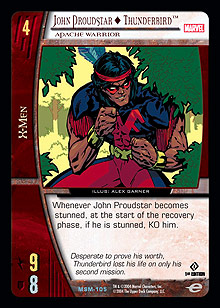 Two, we take the team in an entirely new direction that fits their flavor. (An example would be giving the X-Men Archangel, Angel of Death and Aerial Supremacy.)
Two, we take the team in an entirely new direction that fits their flavor. (An example would be giving the X-Men Archangel, Angel of Death and Aerial Supremacy.)
Three, we design entirely top-down to really sell the card concept’s flavor. (An example would be giving the X-Men John Proudstar ◊ Thunderbird, who’s most famous for dying in his first storyline. Fortunately, his mechanic fits in well with the X-Men’s many recovery effects.)**
At this point, we should have a working file of about 250 cards.
Next entry: Sealed Play Development.
Green Lantern Design Diary
Part Nine: Full Design
Last time, I went over some of the cards we came up with for the initial set. Today is more of the same, only looking a lot more closely at top-down design.
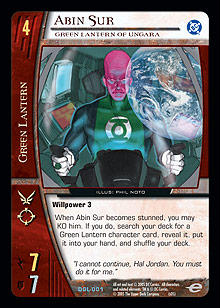 Abin Sur
Abin Sur
Talk about a no-brainer. In the comics, Abin Sur was the Green Lantern who, upon his death, passed his power ring on to Hal Jordan. Character smoothing is a “universal” mechanic, in that we can give it to any team (though each team should do it in its own way), and we went with pure searching. We had Abin (or should I call him “Sur”) floating around cost 4–6, and we went with 4 to increase the likelihood of a player electing to use his power. Also, putting him at 4 made us want to include a Hal Jordan at cost 5 so it would be easy in curve decks for Abin to search out Hal (which best mirrors the story in the comics).
Hal Jordan, Green Lantern of Sector 2814
Speaking of Hal, any long-time Green Lantern reader knows that middle-aged Hal went through a kind of Jack Kerouac On the Road period, when he traveled around trying to find himself. I decided to represent the loner version of Hal by giving him a bonus while he was by himself. This fit in nicely with cards that KO’d other potential teammates, like Abin Sur’s sacrificing himself and Emerald Dawn, plus it might fit into some crazy X-Statix/GL team-up.
Arisia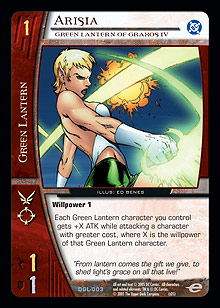 and G’Nort
and G’Nort
There are two requirements to being a Green Lantern: You must be fearless and honest. Now, while we didn’t put an honesty mechanic in the set, we wanted to show off the GL’s fearlessness by giving them a version of the card No Fear, but instead of putting it on a plot twist, we put it on a character.
Arisia is also an example of a design intended to help off-curve decks (like I mentioned up in the Design Bible), as is her little buddy, G’Nort. Since G’Nort is more of a mascot than a warrior, we gave him a power that made the rest of the team happier when he’s around.
It’s also worth pointing out that G’Nort is Scott Elliot’s favorite character, probably because they look alike. (For those of you who don’t know, Scott’s the guy in charge of Organized Play, the team that sets up tournaments hobby leagues and does all sorts of other mysterious things I don’t really understand.)
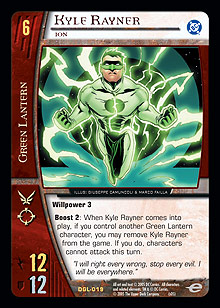 Kyle Rayner, Ion
Kyle Rayner, Ion
Kyle is a hotly debated card on the forums, both in terms of whether or not his mechanic is useful and whether or not his power makes sense. While I’m not going to weigh in on the former, I will at least tell you what we were thinking when we designed him.
In the Ion storyline, Kyle gained so much power (through a convoluted scenario involving Parallax) that he could pretty much do whatever he wanted, including being in multiple places at the same time. You see, like any good Spider-Man, Kyle treated his newfound great power with great responsibility: He decided to police the entire galaxy (thus his flavor text). The only problem was that in his attempt to be everywhere, he kind of had to give up being himself.
We chose to represent his self-sacrifice with his boost power. But you might ask, if Kyle-as-Ion is so powerful, why is he only a 6-drop? The answer is that while we often try to organize or rank characters according to their comic book power level, we also have to keep in mind that sometimes it’s okay to make tradeoffs in order to provide a better play experience. Maybe it would have been more appropriate to make Kyle a 12-drop, but then he wouldn’t get to see as much play as he does now.
Olapet
Olapet carries the seed of her offspring in a pouch she wears (thus her boost power), but that’s not the real story. The real story is that I kept quizzing the rest of R&D on where Olapet’s from. It would go something like this:
 Me: Hey, Justin?
Me: Hey, Justin?
Justin: Yeah?
Me: Where’s Olapet from?
Justin: Who’s Olapet?
Me: A Green Lantern.
Justin: Okay.
Me: Okay, but do you know what sector Olapet’s from?
Justin: (Sighs) No, Danny. I don’t know what sector Olapet’s from.
Me: She’s from Southern Goldstar!!!
Justin: (Puts on headphones)
Man, I miss sitting next to Justin . . .
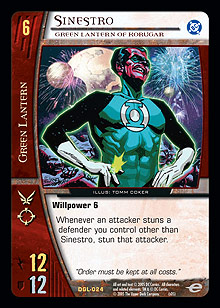 Sinestro, Green Lantern of Korugar
Sinestro, Green Lantern of Korugar
We were getting close to having a fully designed file ready to turn over to development, but one of the cards we were missing was the Green Lantern version of Sinestro. I was pretty sure we had to knock this one out of the park, so I did what any smart lead designer would do. I used our ringer: Matt Hyra.
You see, every member of R&D has his own strengths and weaknesses. For example, Mike Hummel is great as designing cards that push the envelope on what the rules can handle (think J. Jonah Jameson ) and Dave Humpherys is really tall (think someone who’s really tall, only taller).
Perhaps Matt’s greatest strength is his ability to design cards that are totally off the hook. He came up with eight or ten raw card concepts for Sinestro, which I, using what’s probably my greatest strength as a designer, shaped into the finished character we all love to hate. And for those of you out there who don’t know Sinestro’s origin, his mechanic represents the perverse view of order he enforced on his home planet, Korugar, which led to his expulsion from the Green Lantern Corps and got him Banished to the Anti-Matter Universe.
Emerald City
When Coast City was destroyed, Hal Jordan went crazy and tried to recreate it and its inhabitants using sheer willpower. This was a bad thing. Ultimately it led to his murder of the rest of the Corps and his transformation into Parallax. (Well, sorta. The events of “Green Lantern: Rebirth” put a new spin on things, which I won’t go into here.)
This is the lesson of Emerald City: If your home town is destroyed, and you try to recreate it using the power of your mind, you’ll probably go mad and kill everyone and turn into a scary monster. At least for about ten years, at which point they’ll reshape continuity and get rid of the gray around your temples.
Hal Jordan, Parallax and Zero Hour
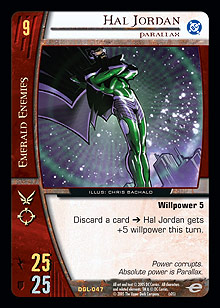 I’ll bet some of you though that these two cards were designed together. They both cost 9, Zero Hour turns Parallax’s (theoretically) unlimited willpower gain into a machine gun of direct endurance loss, and in the comics, the Zero Hour storyline introduced Parallax as the big bad guy. I mean, of course they were designed together, right?
I’ll bet some of you though that these two cards were designed together. They both cost 9, Zero Hour turns Parallax’s (theoretically) unlimited willpower gain into a machine gun of direct endurance loss, and in the comics, the Zero Hour storyline introduced Parallax as the big bad guy. I mean, of course they were designed together, right?
Well, maybe. The truth is, Parallax was designed because I felt that while there was plenty of willpower and a small amount of willpower gain floating around the set, there was no character that could simply generate a nutty*** amount of willpower. So I made Parallax.
I figured players could come up with their own cool uses for the P-man. Then about three weeks later, I was having dinner with Humpherys (I’d lost a bet), and I was lamenting the fact that there wasn’t anything in the set to reward a player for generating a nutty amount of willpower (whether through Parallax or just having a bunch of willpower guys). I mean, there were some effects that scaled up based on your willpower, but I wanted something to really knock players’ socks off. I suggested Zero Hour (in pretty much its current incarnation), and Humpherys got a sour look on his face. Well, more sour than usual.
“No one will play it,” he said.
“Yes they will,” I said. “It’ll be cool! It’ll be splashy!”
“People will laugh at us,” he said.
“No they won’t,” I said. “They won’t laugh—they’ll cry! They’ll cry tears of joy!”
“You’re dumb,” he said.
And the rest, as they say, is history . . .
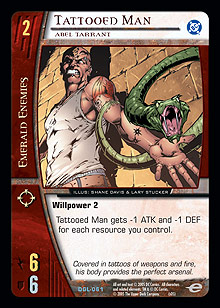 Major Force and the Tattooed Man
Major Force and the Tattooed Man
These guys are an example of what I was talking about up in the Design Bible about card families. Having multiple characters with the same power, we can really hammer home the Emerald Enemies low resource theme. Plus, it allows us to mess around with context by simply adjusting the characters’ stats and points on the curve. Tattooed Man is a beatstick on turn 2, but he gets worse and worse as the game wears on. Major Force works great as the top of your curve when you’re ready to start giving up your resources.
Prison Planet
One of the things we wanted to demonstrate about the Emerald Enemies was that they’re less a team and more a collection of the enemies of the Green Lanterns. Prison Planet was an excellent opportunity to demonstrate this while wrapping it up in something pretty thematic: As the flavor text explains, the prison planet keeps its inmates isolated by keeping them “chronologically out of phase”**** from each other.
Xallarap and Anti-Green Lanterns
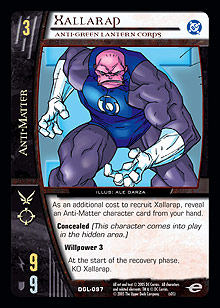 Possibly my favorite bit of top-down design, in the comics these guys were given a ton of power to fight the GLs. The funny part is that they were also only given 24 hours to live before they exploded, which theoretically would inspire them to fight without any thought for their own safety. Go figure.
Possibly my favorite bit of top-down design, in the comics these guys were given a ton of power to fight the GLs. The funny part is that they were also only given 24 hours to live before they exploded, which theoretically would inspire them to fight without any thought for their own safety. Go figure.
Mechanically, these guys were an experiment to see if we could make hugely stat-advanced characters with a pretty steep drawback. The cool part is that if you manage to get them stunned before the recovery phase, their KO power won’t trigger. Of course, you’ll still only get to recover one of them (unless you play a recovery effect), but hey, it’s better than nothing. As an aside these cards led to Dave Humpherys designing Locked in Combat, an otherwise perfectly fine card with the added bonus that it increases the likelihood that you can stun Xallarap in order to keep him around.
Anti-Monitor
Another Matt Hyra special, Ol' “Auntie Monitor” is DC’s answer to Onslaught (in the game, I mean). Since everything is mirrored between the Matter and Anti-Matter universes, we felt it made sense for Auntie to allow you to make one-for-one trades with your opponent. Of course, when all is said and done, one-for-one doesn’t necessarily mean fair, especially when your opponent has no characters or resources, and you’re attacking for 22.
The Crime Syndicate and Qwardian Conglomerate
Originally my plan for the Anti-Matter team was to have every single character start out concealed. But during initial testing, a lot of the hidden area mechanics I’d come up with got pulled and the mechanic that would later be named “Concealed—Optional” got pushed. I decided it would be nice to give all of the “evil twin” characters concealed—optional since they’re always invading our universe and whatnot, while the rest of the team would either have regular concealed or just be normal.
One of the goals of the concealed—optional mechanic is to make the choice of which zone to put the character into meaningful based on the game state (such as whether you need to protect your endurance or you want to go after your opponent’s). Some characters, like Superwoman, work really differently depending on their zone. Others, like Element Man, always go in a particular zone (but were given concealed—optional to sync them up with the rest of the Crime Syndicate or Conglomerate).
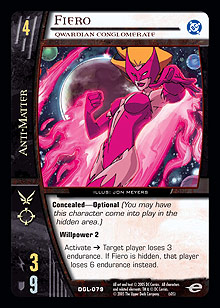 Fiero
Fiero
My favorite concealed—optional character is definitely Fiero, because she embodies three things I was trying push for the Anti-matter team:
One, her concealed—optional power presented an interesting choice: Do you leave her in the visible area where she doesn’t zap for that much but her high DEF protects your endurance, or do you hide her where she makes a pretty good clock, but provides no defense?
Two, she has a really big DEF at the expense of her ATK. One of the goals of the GL set was to explore more nonstandard ATK/DEF/cost combinations, and Fiero fit the bill.
Three, she fits into a stall and/or win without attacking strategy, which is something I like.
Johnny Quick and Slipstream
 Not only are these guys another example of cards with near identical mechanics operating differently based on size (or other factors), but they also demonstrate how top-down design gets filtered through team dynamics.
Not only are these guys another example of cards with near identical mechanics operating differently based on size (or other factors), but they also demonstrate how top-down design gets filtered through team dynamics.
We often give speedsters the ability to ready themselves, and we decided to continue that tradition with these guys. However, we chose to differentiate them from their speedy cousins by tying their power into the concealed—optional mechanic.
Qwardian Watchdog and Manhunter Protector
Continuing the themes of big stats with a drawback and nonstandard ATK/DEF/cost combinations I mentioned above, I also wanted to make characters who either weren’t allowed to attack or with whom you wouldn’t want to attack. Both the Watchdog and the Protector were intended to protect your endurance or your other characters during the early game, though in different ways.
Manhunter Lantern
Manhunter Lantern’s a weird one. On the one hand, having exactly one character with willpower on a team is kind of lame considering willpower often works better the more of it you have. On the other hand, it felt really thematic to give a ring-wielding Manhunter some willpower. On another hand, Manhunters are robots, so they shouldn’t really have willpower, right? On yet another hand, I’m interested in hearing your thoughts on this odd issue.
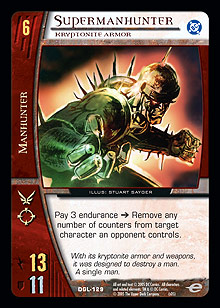 Supermanhunter
Supermanhunter
In another nod to flavor over form, in the Superman set, every card that had to do with kryptonite was able to remove cosmic counters. Since Supermanhunter has kryptonite armor, I wanted him to remove cosmic counters. However, because cosmic wasn’t featured in this set, we improved it such that it could remove any type of counter. Take that, Gnaxos!
Manhunter Science
Another card intended to help off-curve strategies, Manhunter Science works perfectly in swarm builds, as you often run out of cards in hand but have extra warm bodies lying around. Plus, it’s really creepy.
Orinda
My favorite Manhunter card, it really captures the flavor of the Manhunter homeworld, which floated through space cloaked and invisible.
Plans Within Plans
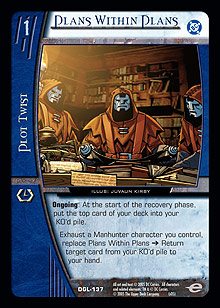 This card was designed not only to represent the Manhunters’ long-term scheming, but also to fit in with their discard-pile based cards such as Highmaster, Manhunter 2.0, or Mark Shaw.
This card was designed not only to represent the Manhunters’ long-term scheming, but also to fit in with their discard-pile based cards such as Highmaster, Manhunter 2.0, or Mark Shaw.
The Fall of Oa
Every expansion has a certain number of archetype-driving cards. The Fall of Oa is a new riff on The Joker, Emperor Joker, in that if you can empty your opponent’s deck, you get a big reward. Sure we could have made the reward on The Fall of Oa “You win the game,” but we already had Sinestro, Enemy of the Corps as our auto-win card. Plus, the phrase “put your deck into your hand” is just too cool. I’ll bet it’s right up Rian Fike’s alley.
In Remembrance
Way back when, I think maybe before the DC Comics expansion had released, Mike Hummel and I met Ben Kalman (Kergillian on vsrealms.com) who asked us a bunch of cool questions. One of them was when were we going to make it so you could power-up characters from your resource row. Well, Kerg, the answer is now. (Um, kind of.)
Millennium
And here we are, the update to my favorite card in all of the Vs. System: Marvel Team-Up. (World’s Finest is a close second.) I love Marvel Team-Up so much that I’ve officially changed Dave Humpherys name to “Marvel Team-Up.”
One of the main problems with Marvel Team-Up is that it’s often not worth investing a number of slots in your deck simply to facilitate a basic team-up strategy. Plus, it’s extra bad when you draw multiples. Millennium allows you to trade exhausting a character for a replacement card. Will it replace Marvel Team-Up as the generic Team-Up of choice? I don’t know. Will it help make team-up decks more viable? Definitely.
Legacy Content
Okay, this is the part where I’d planned to talk about how we designed the legacy content of the set. However, you guys seemed to have tricked me into writing, like, a million words already, so instead of talking about that stuff, I’m instead going to point you to Humpherys’s article on that topic from a few weeks ago.
Personally, I’d rather get a tonsillectomy than read one of his articles, but hey, I figured I’d at least give you the option . . .
Okay, that’s all I got today. Next week it’s more stories. Only this time they’re about the development of Sealed Deck and draft. Hurray!
Q&A
Today’s question is from Rod, an X-Men fan who offers a couple of cool card ideas, which, being that this is an article about design, I’ll critique.
Ok, I'll ask the question that has not been answered yet! :}
Are the X-Men getting :
a: Some sort of direct search to address the Cerebro situation?
b: Some way of reducing the cost of The Blackbird so that it can see more Constucted play?
Don't get me wrong, ’tis a shody workman who blames his tools. But come on, tell me that some help is coming in the form of a plot twist that works in conjunction with Cerebro :)
I'm just saying as an avid fan, 18 years, of the mutants, I would really like to see so more help come our way in those forms.
Thank you so much for your time, and for reading this email.
Focus the Search
Cost 3
As an additional cost to play Focus the Search, exhaust a Cerebro you control.
Search your deck for a character card you control, reveal it, and put it into your hand.
Discard a card from your hand.
Forge
Technical Genius
Cost 5
7 ATK / 7 DEF
Loyalty: As an addition cost to recruit Forge, discard an X-Men character from your hand.
When Forge comes into play, search your deck for a card named Blackbird and put in on Forge. Forge cannot attack this turn. Forge cannot be stunned this turn.
Boost 2: Cards named Blackbird are not unique this turn. :)
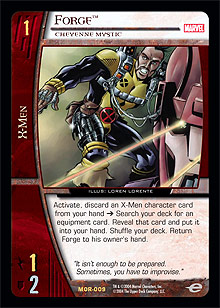 Thanks, Rod. I love emails like this one. To answer your first question, we realize the X-Men are still not tier one in Constructed, though we’re not looking specifically at strengthening Cerebro’s individual power level. Rather, we’re looking at the team on the whole and its place in the metagame.
Thanks, Rod. I love emails like this one. To answer your first question, we realize the X-Men are still not tier one in Constructed, though we’re not looking specifically at strengthening Cerebro’s individual power level. Rather, we’re looking at the team on the whole and its place in the metagame.
As for your card ideas, while I love the flavor of “Focus the Search,” I worry that it’s a bit too narrow, in so far as the card requires you to have Cerebro specifically before you can play it.
Generally, we try to avoid having cards that specifically reference other cards, unless they’re telling you to go fetch the other card. And the times we do have cards reference other cards by name, it’s usually a card referencing a group of cards all with the same name. For example, Cadmus Labs references Superman, but there are several characters named Superman.
Although I guess I could see the card doing something basic, which is then improved if you control Cerebro. How about:
“Search your deck for an X-Men character card, reveal it, and put it into your hand. Discard a card unless you control Cerebro.”
Or maybe something a bit sillier:
“As an additional cost to play Focus the Search, exhaust a character named Professor X or a location named Cerebro you control. <p> Search your deck for an X-Men character card, reveal it, put it into your hand, and shuffle your deck.”
The main issue I have with Forge is that he has too much text. Vs. is already a complicated game with lots of power floating around, so I’d rather try to keep him a bit simpler. I like the idea that he can’t be stunned, which protects The Blackbird from the auto-KO. And I like the idea that if he’s piloting or building the ship, he shouldn’t be attacking. But what if we try to simplify things.
How about if we make him concealed—optional in order to represent that he might be back in the lab or out fighting with the team? To make him a kind of weak attacker, we’ll just give him a lower ATK. Now, how do we make him “build” The Blackbird? I like the boost idea and the non-unique idea, so maybe something like this:
Forge
24 Blackbirds Baked in a Pie
Cost 4
3 ATK / 8 DEF
Concealed—Optional (You may have this character come into play in the hidden area.)
Forge can be equipped while in the hidden area and with any amount of equipment.
Pay 2 resource points >>> Your equipment cards are not unique this turn. Search your deck for an equipment card with cost 2 or less and equip it to Forge.
I’m not sure about the template, and it still has lots of text, but I think it’s pretty cool. What do you think?
Okay, that’s all for this week. Tune in next time for a look at Sealed play.
Send questions or comments to dmandel@metagame.com.
*I like to use big words because they make me look more smarter. I figure it’s important to point out that we don’t have like a textbook of vocabulary we use during the set creation process. I just try to break things using terms like this because they can be helpful to understanding. Also, it means I get to have funny IM conversations with other R&D guys where I ask what the opposite of “holistic” is, and they call me pretentious and/or an idiot. Huzzah!
**I’m sure some of you are thinking, “Wait a minute! He said designers only mess around with a team’s legacy content if development says the team’s A-OK in the metagame—so what’s with all this designer-generated X-Men content?”
To answer your imaginary question, designer-generated cards don’t have to weak. Just because they’re not primarily intended to bring a team up to tier one, doesn’t mean that they can’t also do so. Plus, having developers create legacy content is a relatively new aspect of our process.
***Insert your own joke about Ch’p here.
**** Check out http://glcorps.dcuguide.com/profile.php?name=oansciencells for more info.